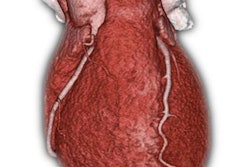Tuesday, November 29 | 11:30 a.m.-11:40 a.m. | SSG09-07 | Room E450B
Researchers from Switzerland have found a way to evaluate bone mineral density in the subchondral bone using high-resolution CT, paving the way to better understanding of osteoarthritis, leading to treatment or a cure."Despite its being a major healthcare issue, there is still no cure available to treat knee osteoarthritis," wrote Dr. Patrick Omoumi in an email to AuntMinnie.com. "This is in part due to a lack of understanding of the pathophysiology of osteoarthritis. Recent observations suggest that subchondral bone could play a central role in the disease process."
The investigators developed a technique to allow 3D evaluation of the entire subchondral bone in the joint, based on the high-resolution images provided by CT, to analyze changes in the subchondral bone along joint surfaces.
Previous studies have suggested that bone could play a central role in the pathogenesis of osteoarthritis, the authors wrote in their abstract. Bone mineral density may be key to understanding because it is related to load transmission according to Wolff's law, and, therefore, to the mechanical constraints on cartilage, they explained.
Dual-energy x-ray absorptiometry (DEXA) is an inferior method that allows only crude evaluation of proximal bone mineral density at the tibia. This study enabled the characterization of the femoral and tibial subchondral bone mineral density in knees with and without osteoarthritis, demonstrating the performance of subchondral bone mineral density assessment.
"This tool will allow us to improve our understanding of the role of subchondral bone in osteoarthritis," Omoumi said.




















